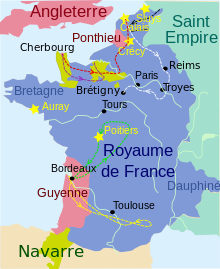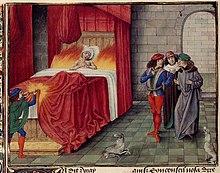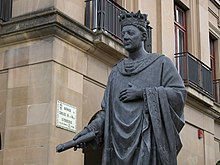Charles III of Navarre
| Charles III | |
|---|---|
Olite Palace, Navarre | |
| Burial | |
| Spouse | |
| Issue more... |
|
| House | Évreux |
| Father | Charles II of Navarre |
| Mother | Joan of Valois |
| Signature |  |
Charles III (
As a young man, Charles was frequently sent by his father, King
Charles's personal life was somewhat turbulent. His marriage to Eleanor of Castile suffered a long crisis early in his reign over the status of their daughters and his illegitimate children; the couple reconciled after Charles affirmed their daughters' exclusive right to succeed him. Charles skillfully secured a balanced web of alliances through the marriages of his sisters and daughters to French lords and Iberian princes, ensuring a long-lasting peace in Navarre. He strove to increase the royal prestige through art patronage, court extravagance, and construction works. Having outlived most of his children, he was succeeded by his third daughter, Blanche I.
Background and childhood
A member of the
King Charles II returned to Navarre in November 1361, leaving his wife and son behind in France. When in January 1363 it was her turn to move to Navarre, Queen Joan left Charles in the custody of his aunt Blanche, sister of his father and widow of his maternal great-grandfather King Philip VI of France. Charles was reunited with his mother when she returned to France in December 1365, and the following August Charles set foot in his father's kingdom for the first time.[2]

Charles's parents repeatedly went back and forth between the family's French fiefs and Iberian kingdom; during his father's absence in 1369, Charles was already titled lieutenant of the kingdom despite his young age.
Marriage
On 27 May 1375, in the Castilian town of Soria, Charles married Eleanor, daughter of King Henry II of Castile, sealing the peace between their fathers. Both Charles and Eleanor were in their early teen years at the time of their wedding. She remained in Castile, where Charles visited her when he was not in Navarre or representing his father at the French royal court in Paris.[7]
In 1378, Charles was sent by his father on an embassy to King Charles V of France. The king of France had his nephew arrested and the Évreux possessions in France embargoed, except Cherbourg, which the king of Navarre had leased to the English. During an interrogation, the young Charles revealed his father's plan to seize the Castilian (formerly Navarrese) town of Logroño. The king of France alerted the king of Castile to the plot, and the latter promptly invaded Navarre and forced its king to sign the Treaty of Briones.[8] Eleanor played a key role in securing Charles's release in 1381 by having her brother King John I of Castile exert diplomatic pressure on France. Upon his release, Charles joined Eleanor in Castile.[7]
Charles and Eleanor's first child, a daughter named Joan, was born in Castile in November 1382. Two more daughters were born to the young couple in Castile: Marie, in 1383 or 1384, and Blanche, in August 1385. Twin daughters were born to the couple the following year, but only one, named Beatrice, survived infancy.[7]
Reign

Charles III became
Marital problems
The early years of Charles III's reign were marred by the breakdown of his relationship with his wife, Eleanor. She and their daughters joined him in Navarre upon his accession, but the new queen soon fell gravely ill. She returned to Castile as soon as her health began to improve and took the princesses with her. Her refusal to return for the next seven years, despite embassies sent by Charles, damaged the relations between her husband and her brother King John I of Castile. When the latter became exasperated by her abandonment of her "great obligations", she claimed that Charles failed to receive her and treat her as befit her.
Still estranged from Eleanor, Charles underwent coronation alone in 1390.[12] From that year on, Charles made a series of moves to repair his marriage, the first of which was to assure Eleanor that he intended to be succeeded by the issue of their marriage. He summoned their eldest daughter, Joan, to Navarre to be sworn in as heir presumptive to the throne. The ceremony, attended by the nobility of Navarre and Castilian envoys, was held on 25 July. Eleanor did not find this sufficient, but the death of her brother John and the accession of her nephew King Henry III of Castile, who was less sympathetic to her cause, forced her to compromise. She demanded further assurances of her safety, and Charles accordingly swore on the Christian cross before Castilian representatives that he "would not kill nor maim nor seize nor allow her to be killed or maimed or seized" and that he "would protect the life and health of the said queen with all of his power" and "otherwise treat [her] in all things as a good husband should treat his wife". Eleanor then returned to Navarre, reuniting with Charles in November 1394 in Tudela.[13]
Soon after their reconciliation, Charles and Eleanor had another daughter, Isabel, born in July 1396.
Diplomacy
In 1393, Charles procured a link to the Aragonese royal house by arranging for his sister Marie to marry Duke
Charles excelled in diplomacy: much of the peace and prosperity Navarre enjoyed during his reign can be attributed to the matrimonial alliances he forged with his nobles and rulers in Iberia and
Succession plans


From 1401 to 1402, Charles conducted marriage negotiations with King
Charles entrusted the kingdom to Eleanor and their daughter Joan from 1408 to 1411, when he was seeking compensation from the French royal court for lost territories.[17] When Blanche was widowed in 1409, Charles used his new connections at the French court to negotiate for her to marry the French king's brother-in-law Louis of Bavaria or Edward of Bar.[20] The death of his childless eldest daughter, Joan, in July 1413[17] prompted Charles to seek a closer match for Blanche, who became the new heir presumptive.[20]
Blanche's situation in Sicily was precarious after the deaths of her husband and father-in-law left her in charge of the unstable island kingdom in the name of the new king,
In 1416, following the examples of the kings of France, Castile, Aragon, and Portugal in dealing with the
The Aragonese remained determined to secure Blanche's marriage for themselves. Their queen,
Last years

Charles made great effort to exalt the monarchy through
On 8 September 1425, having woken up healthy and cheerful,
Legacy

Charles III left to his daughter a stable and prosperous realm.[27] Whether he saw himself primarily as a French prince or an Iberian king remains debated by historians, but it is clear that he oversaw a steadily increasing Iberianization of Navarre.[28] Traditional historiography portrays Charles III's reign as a time of internal withdrawal, as opposed to his father's active part in the Hundred Years' War; finance reforms, which restored a measure of prosperity and social contentment to the kingdom after Charles II's turbulent reign; and courtly splendor. Charles III also demonstrated a significant aptitude for diplomacy. In contrast to his father, Charles "the Bad", Charles III therefore earned the cognomen "the Noble".[10]
Issue
Charles had seven daughters and two sons with his wife, Eleanor of Castile:
- Joan (1382–1413), who was his heir presumptive and married to John I of Foix[29]
- Maria (1383 or 1384–1406),[30] who was gravely ill along with Eleanor in the immediate aftermath of Charles's accession and remained in poor health throughout her life[18]
- Blanche (1385–1441),[7] Charles's ultimate successor, who was married successively to Kings Martin I of Sicily and John II of Aragon
- James II of La Marche[18]
- Daughter, twin sister of Beatrice, who died young[31]
- John IV of Armagnac
- Charles (1397–1402),[33] who was heir apparent to the throne of Navarre during his short life[12]
- Louis (1402), who died within months of his birth[14]
- Margaret (1403),[14] who died young[34]
Additionally, Charles had several illegitimate children, including:
- Lancelot (by Maria Miguel de Esparza), who had a church career[35]
- Godfrey, who married Teresa Ramírez de Arellano[35]
- Joan, who married Louis de Beaumont, 1st Count of Lerín[35]
- another Joan, who married Iñigo Ortiz de Zúñiga[35]
References
- ^ Ramírez Vaquero 2007, p. 11.
- ^ a b c Castro Alava 1967, pp. 24–29.
- ^ García Arancón 2014, p. 325.
- ^ a b García Arancón 2014, p. 326.
- ^ Castro Alava 1967, p. 27.
- ^ García Arancón 2014, p. 336.
- ^ a b c d e f Woodacre 2013, p. 78.
- ^ Herreros Lopetegui 1993.
- ^ Woodacre 2013, p. 77.
- ^ a b c d García Arancón 2014, p. 338.
- ^ a b Woodacre 2013, p. 79.
- ^ a b c d Woodacre 2013, p. 81.
- ^ a b Woodacre 2013, p. 80.
- ^ a b c Woodacre 2013, p. 84.
- ^ a b Woodacre 2013, p. 82.
- ^ a b c García Arancón 2014, p. 339.
- ^ a b c d e Woodacre 2013, p. 85.
- ^ a b c d e Woodacre 2013, p. 86.
- ^ Woodacre 2013, p. 88.
- ^ a b Woodacre 2013, p. 90.
- ^ Woodacre 2013, p. 89.
- ^ a b Woodacre 2013, p. 92.
- ^ Castro Alava 1967, p. 394.
- ^ Woodacre 2013, p. 93.
- ^ a b Woodacre 2013, p. 95.
- ^ a b Woodacre 2013, p. 96.
- ^ Woodacre 2013, p. 97.
- ^ Woodacre 2013, p. 3.
- ^ Woodacre 2013, p. 83.
- ^ Woodacre 2013, pp. 81, 89.
- ^ Woodacre 2013, p. 71.
- ^ Narbona Cárceles 2014, p. 647.
- ^ Woodacre 2013, pp. 81, 84.
- ^ Woodacre 2013, p. Chart 3.
- ^ a b c d Woodacre 2013, p. 202.
Sources
- Castro Alava, José Ramón (1967). Carlos III el Noble: rey de Navarra. Institución Príncipe de Viana, Diputación Foral de Navarra.
- García Arancón, Raquel (2014). Sarasa Sánchez, Esteban (ed.). La monarquía navarra, 1234-1512. Monarquía, crónicas, archivos y cancillerías en los reinos hispano-cristianos: siglos XIII-XV. ISBN 978-84-9911-307-4.
- Herreros Lopetegui, Susana (1993). Navarra en la órbita francesa. Historia Ilustrada de Navarra. Pamplona: Diario de Navarra.
- Ramírez Vaquero, Eloísa (2007). Carlos III, rey de Navarra: príncipe de sangre Valois (1387-1425). Trea. ISBN 978-8497043052.
- Woodacre, Elena (2013). The Queens Regnant of Navarre: Succession, Politics, and Partnership, 1274-1512. Palgrave Macmillan.
- Narbona Cárceles, María (2014). "Leonor de Trastámara: (1360-1415) esposa de Carlos III el Noble". Reinas de Navarra. pp. 645–680.
